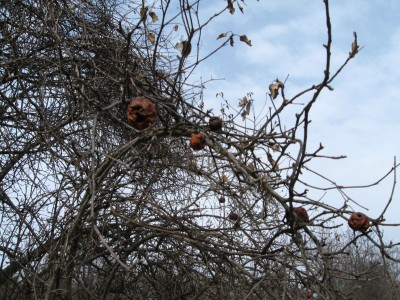Forgotten fruits, Chicago chefs
By martha

When I went to the Forgotten Fruits workshop up in Madison earlier this year, one thing seemed sort of off. All the trees looked like this one.
March = not exactly peak apple season.
Next week, tho, RAFT brings its apple program to Chicago just as the Pippins are starting to fall from the trees. I’m looking forward to Thursday’s workshop at the Botanic Garden, which is led by RAFT majordomo Gary Nabhan in conjunction with gregarious cider expert Ben Watson. It looks like it will revisit much of the information from the spring, with perhaps more of a focus on increasing accessibility to and availability of heirloom apple varieties in urban markets.
I was both inspired and utterly overwhelmed by the wealth of information presented in Madison, in particular the collective knowledge of the apple old-timers, who came from orchards across the country to put their heads together and figure out how to keep the American Summer Pearmain, the Pomme Royal Dyer, the Transcendent Crab, and a host of other gloriously named fruits alive. Sadly these men — many of them lifelong apple growers, and many of them in their 70s and 80s — will not be at the Chicago workshop. But, on the plus side perhaps this time my head will not explode.
Two public events bookend the workshop: On Wednesday at 2 PM Nabhan and Wisconsin orchard-keeper and apple historian Dan Bussey host a field trip to historic Kline Creek Farm. And on Thursday at 6 PM Nabhan and Watson get down to business with an heritage apple and cider tasting at Southport Grocery; proceeds benefit the excellent Chicago Rarities Orchard Project (or “CROP”), a fledgling orchard project spearheaded by a handful of Chicago’s own fruit freaks. (One of them is also a soup freak.) For more info on all this see the Slow Food Chicago site.
All the apple action is happening in conjunction with next week’s Chef’s Collaborative National Summit, which is convening in Chicago on Tuesday at Kendall Collge to rally the culinary troops around the theme “Bringing Sustainability to the Table.” Now, locally grown produce, snout-to-tail eating, and on-site compost may all seem like no-brainers in Chicago, where you can’t throw a fork without hitting a plate of rooftop-grown microgreens, but get outside the Mado-North Pond-Publican axis and there are still a whole lot of Sysco cans on the shelf out there. (Though I shouldn’t dis Sysco. The committment with which this industry giant — for so long the easy fall guy for all that’s wrong with the food service business — has thrown its considerable weight behind the cause is both fascinating and heartening.) Restaurants notoriously operate on razor-thin margins, and the current economic climate is making things particularly rough and bulk buying particularly seductive. So, IMHO, any effort to bring together professionals to try and hash out a way to run a sustainable business and stay in business is vital, now more than ever.
With speakers ranging from Rick Bayless to Fred Kirschenmann, president of Dan Barber’s Stone Barns Center for Food and Agriculture and a longtime force behind the Leopold Center for Sustainable Agriculture at Iowa State (ground zero for much critical research underpinning those long lines at the Green City Market — this white paper on the disappearing “agriculture of the middle” is particularly good, if nerdy, reading) the summit looks to be a rich day and a half. There’s even a panel on local beer, wine, and spirits, a subject ever-near and dear to my heart.
It should be a busy week.
“Now, locally grown produce, snout-to-tail eating, and on-site compost may all seem like no-brainers in Chicago, where you can’t throw a fork without hitting a plate of rooftop-grown microgreens….”
It begins to all look very faddy. I’m showing my age, but I lived through all the back-to-the-land, Earth Mothering, grow-your-own sprouts, Earth Day consciousness of 30+ years ago, and it all seemed to go away in the ’80s and ’90s. I can’t help but think that if all the sustainable talk of that era had actually been implemented outside of Alice Waters’ restaurant, things might be very different today.
That’s probably true. It does seem that right now there’s a certain amount of muscle (and, money) being thrown behind it all, what with the Local Food, Farms, and Jobs act, the Frontera Farmer Foundation’s recent Top Chef windfall, etc. Maybe this time around we’ll see some longer term results after the fog of hype clears.